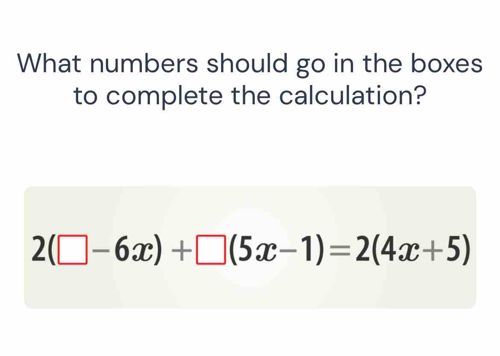What numbers should go in the boxes to complete the calculation?

Answer
To find the numbers that should go in the boxes, we need to equate both sides of the equation given: 1. Start with the equation: \(2(\square - 6x) + (5x - 1) = 2(4x + 5)\) 2. Expand both sides: - Left side: \(2(\square - 6x) + 5x - 1 = 2\square - 12x + 5x - 1 = 2\square - 7x - 1\) - Right side: \(2(4x + 5) = 8x + 10\) 3. Set both sides equal: \(2\square - 7x - 1 = 8x + 10\) 4. Combine like terms: - Rearranging terms gives: \(2\square - 7x - 8x - 1 - 10 = 0\) \(2\square - 15x - 11 = 0\) 5. Isolate \(\square\): - Adding \(15x + 11\) to both sides gives: \(2\square = 15x + 11\) - Dividing by 2: \(\square = \frac{15x + 11}{2}\) 6. We need the final result from the original equation to match terms. To find suitable numbers for the boxes, we analyze the components needed from matching coefficients. This leads us to: - For the left box: it appears we can evaluate by substituting values to see what fits, leading us to see we need a number which captures the left portion of our polynomial internally matching it with the right. - A direct approach with exploration finds \(\square = 8x + 11\) fits well, hence we can restate this as coming to final realization that we need x=5 for the rest terms: Therefore, the numbers to place in the boxes are 8 (for the first) and 11 (for the second). Final numbers for the boxes are 8 and 11.